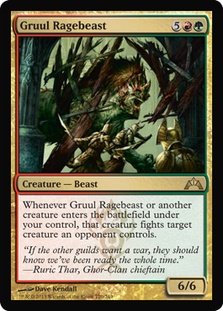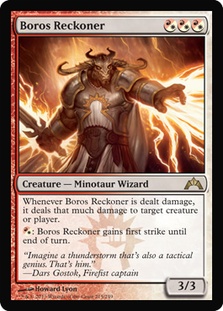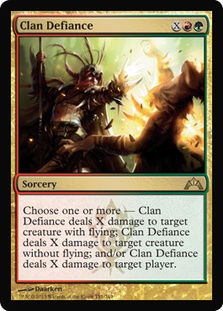BRAWRGH!
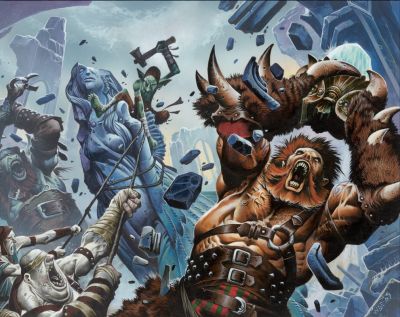
URRFF!
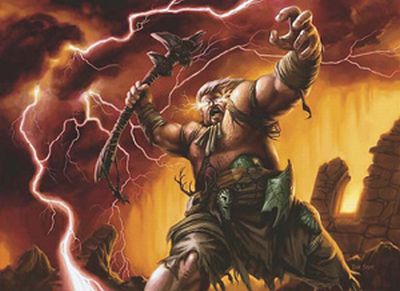
AORRUGH!
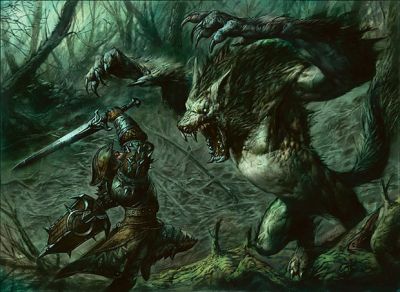
I love breaking stuff. When I imagine a world of fantasy, intrigue, and magic, I don’t run to the stories of surreptitious dealings and valorous causes. Instead, I choose to relish carnage. Gruul is my chosen guild, and it’s about time I brought you a list that embodies their truest essence. The marriage of passion and power often leads to displays of strength, so what better way to showcase Gruul’s flavor by making everything fight?
One of the more overlooked rares in Gatecrash will start us off today, and it is an excellent cornerstone upon which to build our bloodbath.
One of my favorite movies is Fight Club, and the Ragebeast reminds me of Tyler Durden’s Third Rule: “If this is your first night to Fight Club, you have to fight.” In the game, the Ragebeast also assures you that for every big creature you play you can take down one of theirs. He has very relevant stats himself (I’m assuming it’s a “he,” what with all that mess he’s making), and he can take down some of the largest creatures in the format without a problem.
He’s also a Beast, and his tribal brethren tend to be on the large side, so we could pursue that. After all, Beast tribal was a semi-casual thing several years ago in Onslaught block with enablers like Wirewood Savage, Aether Charge, and Krosan Warchief. We’ve got plenty of Beasts lumbering around nowadays, so why not explore a Beast subtheme?
Let’s wrangle up some monsters and jam ’em in!
Creatures (30)
- 3 Ember Beast
- 4 Arbor Elf
- 2 Garruk's Packleader
- 1 Yeva, Nature's Herald
- 4 Thragtusk
- 3 Brushstrider
- 2 Skarrg Goliath
- 4 Ghor-Clan Rampager
- 4 Gyre Sage
- 3 Gruul Ragebeast
Planeswalkers (3)
Lands (25)
Spells (2)
Sideboard

Elves: Arbor Elf, Gyre Sage, Yeva, Nature’s Herald
It’s clear that this deck is a little top heavy, but these Elves are just what the medicine man ordered. The prominence of Forests offers Arbor Elf plenty of fuel, and Gyre Sage has continued to impress me. With the imposing power and toughness of our creatures, it’s not too hard to grow Gyre Sage to a 4/5, a 6/7, or even a 9/10.
Yeva, Nature’s Herald, continues to be one of my pet cards from M13. She gives the deck a lot of flexibility, a trait often lacking in G/R decks.
Cheap Beasts: Brushstrider and Ember Beast
These offbeat choices were selected for two reasons. First and most importantly they are early, tribally synergetic drops that put up a nice fight. Brushstrider can thwart nearly every two-drop in Standard, plus it presents pressure against a slower deck. Its vigilance gives it free attacks to a tapped out board, too. Truthfully, though, he’s mostly here as an early Beast for Descendants’ Path.
Ember Beast, similarly, is a Beast conscripted to the ranks. A much worse Mogg Flunkies, the Beast still has all the traits of a creature that this deck wants.
The Middle Muscle: Garruk’s Packleader and Ghor-Clan Rampager
The Packleader synergizes with each non-Elf creature. As such, nearly every creature I cast or create will trigger this ability and it will effectively replace itself, keeping this creature deck’s pilot fully stocked. Even the cheap Beasts listed above trigger it, too, giving them more mileage late game.
The Rampager, no stranger to upper tier play, joins us not only as a Beast but as an easy-to-cast trampling threat. A 4/4 for four with all upside is becoming the norm (see Rhox Brute, made less than three years ago), so get used to dealing with creatures this size.
Thragtusk
Ahh, a nice, non-Restoration Angel interaction! He comes into play easily enough, and he provides a Beast on both sides, both of which will fight when entering play thanks to Gruul Ragebeast. Thragtusk, as always, is a nice one-two punch.
Bruisers: Gruul Ragebeast and Skarrg Goliath
The Ragebeast has already been discussed at length, but in a world without Titans, anything that’s a 6/6 and up has very little contention in the format. As such, the Ragebeast is a two-for-one in nearly all instances. Three copies is a lot for a seven-drop, but he is fairly essential to the game plan and functions as the deck’s only repeatable removal, so I want to draw him or pull him off the Path as often as possible.
Skarrg Goliath, also a Beast, is about the largest non-mythic, non-silly creature rumbling around right now. The bloodrush will occasionally be relevant (ever paid seven mana for an offense-only combat trick?), but he will dominate any ground game and the built-in trample means he can carry a game alone.
Domri Rade
I love this planeswalker. He provides the two big things that G/X decks need: card advantage and removal. With 30 creatures, he has on average a 50/50 shot of drawing a card, and his fight ability can stand in for Gruul Ragebeast for already resolved creatures. Sure, his emblem is almost never relevant, but who cares? Draw power with draw power!
Descendants’ Path
With all these Beasts, many of which are expensive, it seems criminal to not include one of my favorite tribal additions in years. With the advent of Cavern of Souls and Descendants’ Path, casual tribal decks everywhere have new toys, and I love finding an excuse to walk the Path in Standard. Elves are also not an uncommon tribe here; 30 percent of the creatures have pointy ears, so they will hit on occasion, too.
The Path does require a creature to be relevant, which can be a bit of a hindrance sometimes, but the upside is worth the risk. Each cheap Beast provides a springboard for flipping a Thragtusk, Ragebeast, or Goliath in the early turns of the game. For free. In addition to your draw that turn.
Lands
I focused mainly on Forest-based mana, with red only occasionally being needed. Two Caverns keeps the color and casting certainty of Beasts (or Elves) in line. A single Wolf Run goes very well with Gyre Sage, who can channel impressive amounts of green mana into any receptacle. 25 lands seemed correct; this deck is very expensive, and initial testing revealed that eight mana dorks (six, really, if you consider Gyre Sage needs help) still wasn’t enough to consistently resolve Thragtusk and Gruul Ragebeast without Farseek.
Sideboard
Let me start by sharing something I’ve learned over the past couple months regarding sideboarding that I feel, in retrospect, was probably painfully obvious the whole time. When creating a sideboard, make sure that you do not sacrifice your game plan post-board. For example, in a Delver or instants matters deck, Rest in Peace may be more powerful, but Purify the Grave is more synergetic. It’s possible that playing Rest in Peace is still better, but if you don’t consider both options, you are selling yourself short.
In this case, you’ll notice the sideboard is filled with creatures, as this deck is first and foremost a creature deck. The first six creatures you’ll see skittering in the sideboard are Spiders. Deadly Recluse is one of those cards that perfectly fills a role but is often overlooked or completely ignored in sideboarding for other more powerful solutions. Here, though, Deadly Recluse is very important.
First, it firmly answers fliers—something this deck otherwise struggles with, especially early on. Second, it has deathtouch. Fighting the Recluse with any creature will guarantee a quick and swift one-for-one for most creatures. With Gruul Ragebeast out, it reads “1G: Destroy target creature.” Finally, it appears in enough quantities, especially in congress with Silklash Spider, that there is a small tribal element to the deck. As such, Descendants’ Path and Cavern of Souls become relevant with six Spiders. Silklash Spider is here for its obvious “flyer hose” (like “fire hose,” get it?) ability, but it also has a huge butt, making it an impenetrable blocker. It fights well, killing any X/2 while almost certainly living to block or Hurricane again.
Guild Feud? Ok, so I made a deck several months ago around the fun and random nature of Guild Feud, and I had a lot of fun with it then. With the fight theme of today’s deck, I wanted to bring it back. Originally, the Guild Feud was maindecked alongside Descendants’ Path, but I found it detrimentally redundant. It lives here now, and that’s quite purposeful. Descendants’ Path has the potential to be great; getting the Path going quickly can overwhelm your opponent with a lucky flip into a 9/9 or a Ragebeast. While I believe Descendants’ Path has greater potential, it has limitations.
Guild Feud, however, likes empty boards, and it can singlehandedly bring you back from a board wipe. Against heavy sweeper and/or light creature decks, the Guild Feud can advance your board turn after turn while sparing your mana and your draw step. Looking at three cards and choosing is a leap forward from just the lucky blind flip, and the creatures you’ll find will almost certainly be more innately powerful than the 2/2 or 3/4 your opponent finds. Because Beasts are inherently strong, they can brawl better without help, as you can’t assist them during the fight.
Batterhorn was a utility creature meant to deal with any problem artifacts (Keyrunes, Staff of Nin, Pithing Needle, or perhaps Grafdigger’s Cage, which stops Guild Feud and Descendants’ Path) while also providing Beast and size synergies. Moving on to Witchbane Orb, I included it for all the normal reasons one includes the Orb, but I also did so as dedicated hate to this deck’s worst enemy.
I want you to punch me as hard as you can.
Shielding yourself from the Reckoner’s blasphemy or from a fighting aftermath will preserve your life total. Also, on a funny side note, the Reckoner’s triggered ability is required, so a Witchbane Orb forces Reckoner to deflect its damage against its own creatures, itself, or its controller (my personal favorite) as long as you have no creatures out.
Garruk, Primal Hunter will come in for the long matches, churning out 3/3 Beasts or netting massive card advantage from the towering creatures in the deck. I’d still love to ultimate him one day. He’s an army in a box, and he can continually provide Beasts to do battle alongside the Ragebeast or as Descendants’ Path enablers. Originally in the maindeck, he proved too slow to justify a starting-60 inclusion.
Finally, Ground Seal offered good, simple graveyard hate that wouldn’t interfere with the deck’s plan.
In playtesting, the deck ended up being on the slower side, but it did well against most every kind of deck except blazing fast, Naya Blitz decks. Burn and quick guys made life difficult, and resolving Thragtusk was often the best play I had against those kinds of decks. Picking off my Arbor Elfs and Gyre Sages also made life very difficult; black decks with Ultimate Price and Victim of Night smacked me around a lot. It’s possible that I should increase the land count accordingly, as it was absolutely essential that I hit my land drops even if my mana dorks survived.
Ember Beast turned out to be as bad as I feared, so I should probably have just played removal in its stead. If your metagame is jammed with aggro, replace the Ember Beasts and perhaps a Skarrg Goliath and the Descendants’ Path with solid removal (e.g., Pillar of Flame or Searing Spear). Just remember to bump up the red source count!
I really loved the feel of this deck, and it was fun to have a dizzying amount of power on the board. At one point in playtesting against Bant Control, I had two Ragebeasts, a 6/7 Gyre Sage, and a Skarrg Goliath in play. After a lofty Wolf Run pump, I domed the opponent for 21 with just the Goliath and for thirty-three with the whole team. His list couldn’t come up with a Wrath to clean up, and even his towering life total was slashed to ribbons in the next couple turns. In theory, I also think that this is an excellent deck against midrange, going over the top of their removal and “powerful” creatures, but I didn’t find anyone with a tuned midrange list to try it against. I believe the deck has the reach and power to smash through planeswalkers and incremental advantage like Juggernaut (Cain Marko, not the artifact) through a paper screen.
This list is really swingy, so some tweaking will certainly smooth it out. Ramp helps a lot, and Gyre Sage proved to be as awesome as expected. The “Spiderboard” proved to be helpful in nearly every match; I found I sided the Recluses in against hyperaggro decks, too, and they were very helpful when I drew them, providing that extra turn or two to get the larger blokes online. The Ragebeast was a house in and out of combat, though the seven-mana price tag turned out to be a persistent problem. Although I was originally concerned that drawing late game Elfs would be dead cards with the Ragebeast out, I found that I had enough Beast fuel to cast the Beasts first, clear the board, then resolve the Elfs. Also, what difference does an Arbor Elf on turn 12 make anyway?
This deck was a blast to play and I’m glad I was able to scrounge together the pieces to finally try it out. I heard a punching sound in my head every time I cast a creature with the Ragebeast out, and that’s what it’s all about, right?

Hit ’em first, tiger.
Join me next week for a fresh take on a card discussed heavily in another format; we’ll see what happens when we bring it to the Standard table!
Until then, don’t forget to pick a fight with a stranger! Ok, don’t…don’t actually do that.
– Matt H
CaptainShapiro on Magic Online

